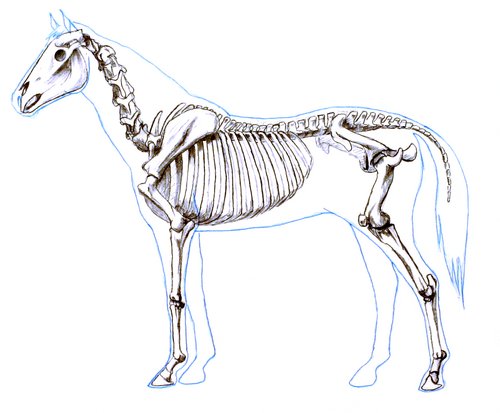A month later.. I'm back. Sorry about the wait everyone. Things have gotten busy around here.
Just recently I had a mare finally foal out. We had been waiting and waiting, partly because we didn't quite know when she was going to foal. But she finally did and to my disappointment she was not a perfect baby. I found her across the fence from her mom and as I tried to help her up, I quickly realized that there was something wrong with her legs, being she could not stand. In all my excitement it didn't bother me at that moment and I ran back to get help so that she could nurse. After things settled down, I thought more about how she looked and wondered what she had.
First Observation: Her legs were crooked. She looked like she was contracted in her knees and that her fetlocks were quite weak. Her hind end looked pretty regular, other then the fact that she was very weak and couldn't stand up for long.
Any ideas?
As I spent more time with her and talked to a few people, I started to see more things in her that I had missed in the beginning. For example, yes her knees couldn't straighten out, but it was actually her fetlocks that were contracted that were causing her knees to be crooked. As I watched her try to walk, I realized that she was walking on the tips of her toes. And the last thing that I noticed near the end, was that she had a bit of a monkey mouth(her bottom jaw stuck out farther)
Any guesses?
I didn't want to guess it at first, but realized that she was indeed a slightly hypothyroid baby. So I spent most of my day and the following keeping her eating, mainly from a bottle and sometimes from the mare. However, on the 3rd day, just when I thought she was going to be ok, things went downhill. She quit eating, wouldn't try to stand much and eventually died that afternoon. So apart from the fact that she was hypothyroid, it seemed like she must have had something else inside her that wasn't working quite right.
But back to hypothyroid babies... Foals that have this are usually contracted in the tendons all the way around. They have extreme monkey mouths and are usually missing hair in lots of areas. These are extreme hypothyroid babies.
So why do some mares foal these kinds of babies? Well there's lots of possibilities. A main one is if the mare is very overdue and if she lacked selenium during her pregnancy. Other reasons could be if she was eating something very green, or if there was uteral problems.
Treatment?
After 2 weeks if the legs are still crooked there are a couple things a vet can do like periostrium stripping or transphyseal bridging. Something you can do is continually stretching their legs, first wrapping their legs in warm water mixed with linament.
However some things just don't work out how you want them to, like my baby. In that case, try again and learn from the previous experience!
 Belladonna - for early stages of collic
Belladonna - for early stages of collic
 There are many more of course. Like Rhus Tox and Ruta Graveolens(not to be given to mares in foal), which are usually given together to help heal ligaments and tendons. Usually these remedies can be given in a small tablet form.
There are many more of course. Like Rhus Tox and Ruta Graveolens(not to be given to mares in foal), which are usually given together to help heal ligaments and tendons. Usually these remedies can be given in a small tablet form.  Have you ever heard of 'dog tracking?' If any of you haven't, it's basically when a horse moves crookedly. So when you watch them trot away or towards you, you will notice that their hind end travels out to the side. This movement usually indicates that the pelvis is most likely rotated.
Have you ever heard of 'dog tracking?' If any of you haven't, it's basically when a horse moves crookedly. So when you watch them trot away or towards you, you will notice that their hind end travels out to the side. This movement usually indicates that the pelvis is most likely rotated.



